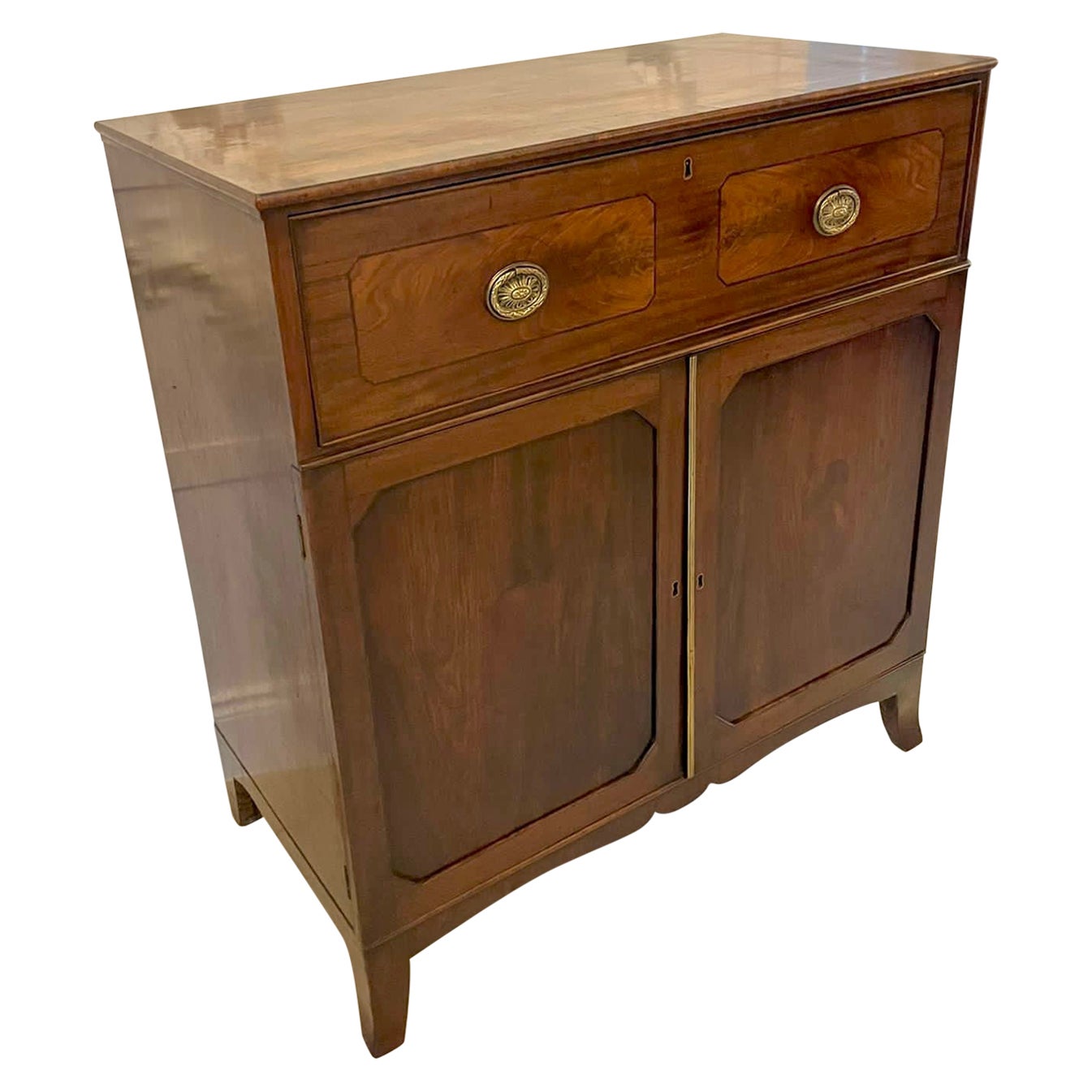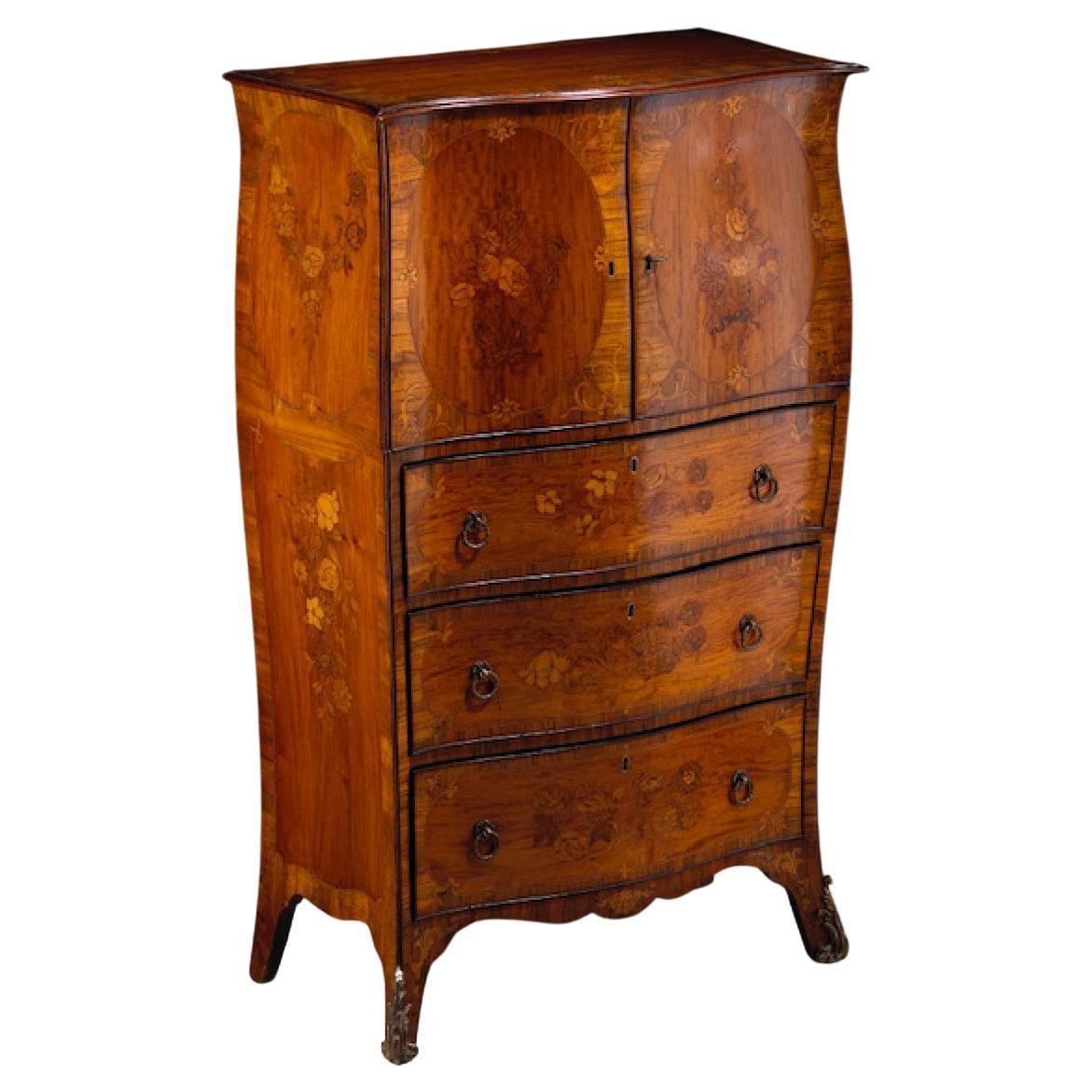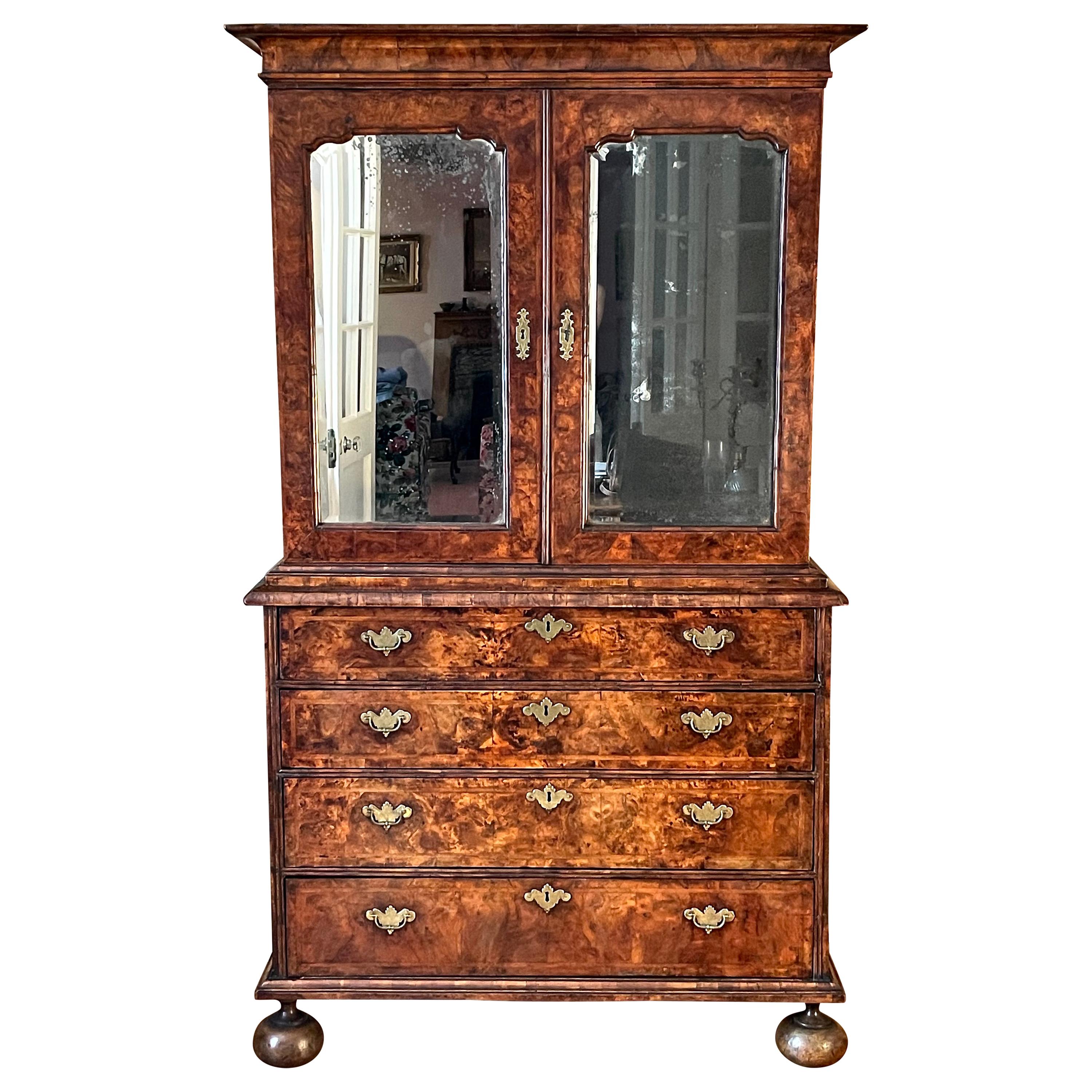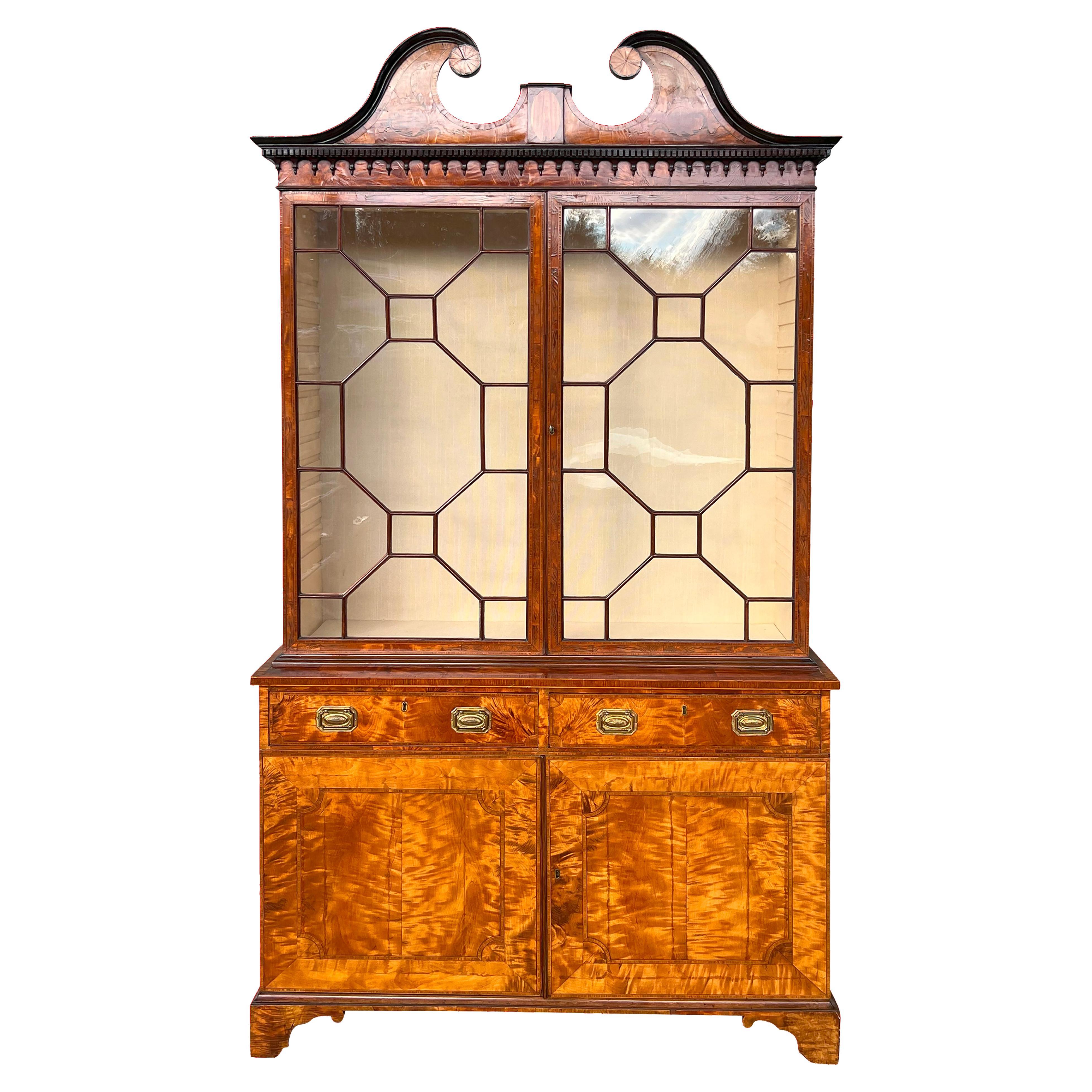Items Similar to George III Oak Secretaire Estate Cabinet
Want more images or videos?
Request additional images or videos from the seller
1 of 12
George III Oak Secretaire Estate Cabinet
About the Item
Truly wonderful early 19th Century George III oak secretaire estate cupboard.
This cupboard is of small proportions and was made by an accomplished cabinet maker.
In totally untouched condition, original handles, hinges, locks, keys, feet, and the most beautiful warm rich colour. The moldings are very fine and precise, with beautifully swept feet, double cupids bow fronted interior shelves, and double lopers to support the secretaire drop down front.
Originally from the North English / Welsh Borders.
Circa 1810.
- Dimensions:Height: 76.38 in (194 cm)Width: 40.16 in (102 cm)Depth: 16.15 in (41 cm)
- Style:Country (In the Style Of)
- Materials and Techniques:
- Place of Origin:
- Period:
- Date of Manufacture:1810
- Condition:
- Seller Location:Gloucestershire, GB
- Reference Number:
About the Seller
4.9
Gold Seller
These expertly vetted sellers are highly rated and consistently exceed customer expectations.
1stDibs seller since 2013
164 sales on 1stDibs
Typical response time: 11 hours
- ShippingRetrieving quote...Ships From: Gloucestershire, United Kingdom
- Return PolicyA return for this item may be initiated within 3 days of delivery.
More From This SellerView All
- 17th Century Dutch Oak CabinetLocated in Gloucestershire, GBA 17th century Dutch oak cabinet of nice small proportions and finely balanced carvings to the moulded panel doors. Having a moulded cornice top abov...Category
Antique 17th Century Cabinets
MaterialsOak
- English 19th Century Mahogany Folio CabinetLocated in Gloucestershire, GBWonderful English 19th Century mahogany folio cabinet. This library cabinet features a hide top over two cross-banded panelled doors with a divided inte...Category
Antique 19th Century English Country Cabinets
MaterialsMahogany
- Dutch Display CabinetLocated in Gloucestershire, GB19th Century Dutch display cabinet. This wonderful cabinet has a single paneled door flanked by glass side panels. The door opens to three shelv...Category
Antique 19th Century Dutch Baroque Cabinets
MaterialsWood, Paint
- 19th Century CabinetLocated in Gloucestershire, GBFine quality late 19th Century Arts and Crafts ebonised and amboyna cabinet by Marsh Jones and Cribb. The superstructure with a central mirror flanked by timber panels...Category
Antique 19th Century English Arts and Crafts Cabinets
MaterialsAmboyna
- George III Sheraton Period DeskLocated in Gloucestershire, GBA stunning George III Sheraton Period lady's small tambour fronted desk. Constructed from exceptional figured satinwood with rosewood crossbanding ...Category
Antique 18th Century British Country Desks and Writing Tables
MaterialsSatinwood
- George III Carved Marble CisternLocated in Gloucestershire, GBGlorious early 19th Century Carrara marble cistern of large proportions. The boldly carved, gadrooned, oval bowl, stands on a finely detailed socle. All...Category
Antique 18th Century British Country Planters, Cachepots and Jardinières
MaterialsMarble
You May Also Like
- Fine George III Period Satinwood Secretaire CabinetLocated in Lymington, GBAn exceptional English Sheraton period satinwood secretaire cabinet. Attributed to Gillows. Late-18th century, George III, ca 1790. Measures: H 59 1/2’’ (151 cm) W 30’’ (76 cm) D 19’’ (49 cm). This small, beautifully-proportioned, and sophisticated antique writing cabinet...Category
Antique Late 18th Century English George III Secretaires
MaterialsSatinwood
- Antique George III Quality Figured Mahogany Secretaire Desk/CabinetLocated in Suffolk, GBAntique George III quality figured mahogany secretaire desk/cabinet having a quality figured mahogany crossbanded top with a moulded edge above a secretaire drawer with original bras...Category
Antique 19th Century English George III Cabinets
MaterialsOther
- King George I Ambassadorial Secrétaire-CabinetLocated in New Orleans, LAThis highly important secrétaire-cabinet was crafted for and specially ordered by King George I for the British Ambassador to Russia. From its craftsmanship and materials to its exceptional artistry, it is a work of royal and historic significance that exudes power in each and every detail. The broken pediment at its apex features the simplified royal coat of arms bearing the king’s crown, while the interior is adorned by portraits of the British Royal Family. Placed within the ambassador’s St. Petersburg home, this entirely unique piece of furniture would have been a potent reminder of England's grandeur and political importance. Relations between England and Russia during this period were at an all-time high. Peter the Great had traveled to England in 1698 as part of his widely known “Grand Embassy” tour, wherein he attempted to gain foreign support against the Ottoman Empire. He spent a period of nearly four months there, meeting with King William III and his court on numerous occasions. Noted academic Arthur MacGregor wrote concerning the impact of the trip, “For two decades following Peter's visit, British influence in Russia reached a peak. It manifested itself in social custom, in craft practice and in ships and naval organization... it reached a significant sector of the population before relations cooled once again and the two nations pulled back from this era of unprecedented cordiality.” First and foremost, however, it is a reminder of British might and influence. By the reign of King George I, England had come into its own as a world power. Unique in its design, this cabinet is a reflection of the country’s might. It is crafted from the highest-quality solid walnut and burr walnut adorned by gilded lock plates and engraved hinges. The presence of ormolu at its apex and lining the doors was a rarity for this period, and its addition makes manifest the importance of the design. The outer doors open to reveal multiple interiors, including fifteen separate drawers around a central cupboard; the cupboard doors each bear mezzotint portraits of George I and his father, Ernest Augustus, Elector of Hanover. An etching after the portrait of George I dating to circa 1716 is in London’s Royal Academy. A second, inner pair of doors are adorned by mezzotints of the Prince and Princess of Wales (later Queen Caroline and George II), which are both after portraits by Sir Godfrey Kneller dated 1716 in the Royal Collection. A final portrait is revealed on the very interior of the cabinet, where a mezzotint of Frederick, Anne, Amelia and Caroline, children of the Prince of Wales, resides. An etching (circa 1715-1720) after this portrait can be found in the National Portrait Gallery (London). Apart from its abundance of royal portraiture, the cabinet features stunning painted decoration, including floral designs as well as clouds, birds and trees in a bucolic motif reminiscent of Eden. Its lower portion is a study in both form and function, featuring a fitted secrétaire-drawer above three additional drawers for storage. The cabinet appears in The Shorter Dictionary of English Furniture by R. Edwards from 1964, a text that is regarded as the bible of British furniture design. Edwards describes it as a “writing cabinet...given by George I to the British Ambassador at the Russian court.” The cabinet was likely made for the 18th-century German diplomat and writer Friedrich Christian Weber, who represented English interests at the Russian court from 1714 until 1719. Although Weber’s tenure as ambassador was relatively short, while in St. Petersburg, he authored his account entitled Das veraenderte Russland (The Present State of Russia), which was published in three volumes in 1721, 1739 and 1740. It may, however, also have been made for George Douglas, 2nd Earl of Dumbarton, who served as ambassador alongside Weber in 1716. Diplomatic relations ceased between the two countries in 1721. In 1928, the cabinet appeared for sale at the International Exhibition of Antiques & Works of Art in Olympia. It had previously been in the collection of the Woltner family of Bordeaux, the celebrated vintners who owned the estate Château Laville Haut-Brion and produced wine of the same name. According to the family, Monsieur Woltner was given the cabinet as a gift from an aunt who lived in Russia for many years. After leaving the Woltner collection, the cabinet was acquired by William Berry...Category
Antique 18th Century English Georgian Secretaires
MaterialsBrass
- George III Yew Wood, Satinwood and Floral Marquetry Bombe Secretaire CabinetBy Ince & MayhewLocated in Reepham, GBA charming George III yew wood, satinwood and floral marquetry bombe secretaire cabinet circa 1770 attributed to Ince and Mayhew. The shaped top has elegant eared corners above a pair of cupboard...Category
Antique Late 18th Century European Cabinets
MaterialsSatinwood, Yew
- Fine George I Burr Walnut Secretaire CabinetLocated in Lymington, GBA fine English George I-period burr (burl) walnut secretaire cabinet. Early-18th century, ca 1720. The top section separates from the base and opens to reveal numerous fitted drawers, behind doors with original bevelled arched mirror plates. The base contains a fall-front fitted secretaire with small drawers, two of which have secret drawers. Engraved mounts are contemporary if not original. All locks and cross-grained mouldings are original. Beautiful colour throughout with superb matched burr veneers within herringbone lines. Bun feet are original. Lined throughout in best quality English oak. The well-patinated green, gilt-tooled liner in the writing surface appears original. Very much in the style of John Old & William Ody. One of the most original early-18th century pieces of English walnut cabinet...Category
Antique 18th Century English George I Cabinets
MaterialsWalnut
- George III Satinwood CabinetLocated in Essex, MAIn two parts. The upper section with a broken arch cornice with inlaid pinwheels at the termination of the scrolls. Central oval inlay in the center. Two glazed and mullioned doors i...Category
Antique 1780s English George III Cabinets
MaterialsSatinwood
Recently Viewed
View AllMore Ways To Browse
Estate Furniture
Antique Estate
Estate Antique
Antique And Estate
George Oakes
George Oak
Antique English Oak Cabinet
Bow Cabinet
English Estate
Small Antique Oak Cabinet
Small English Cabinet
Estate Cabinet
Antique Color Kitchen Cabinets
Drop Down Cabinet
Antique Kitchen Cabinet Handles
Country Kitchen Cabinet
George Iii Oak
Oak Molding





